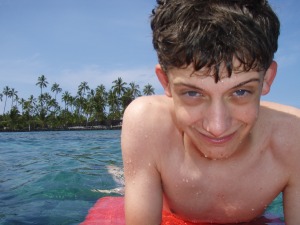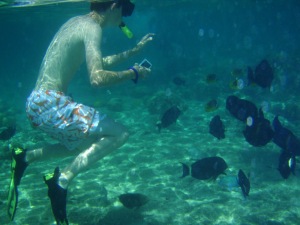By Donnie MacGowan
Coming to my island for a vacation? There are three things I always recommend the first-time visitor do. First, go on an air tour. Secondly--go to a luau. Finally, I advise people of every age to get in the water and go snorkeling. The "one-one-one, experiencing the world through the fishes' eyes" magic of swimming in those bath-warm lagoons surrounded by clouds of tropical fish is an amazing, restful and restorative pursuit-you will find your mind going back to that experience over and over through the years much more so than many of your other travel experiences. Part I of this series discuses Snorkeling Gear; Part II of this series will discuss Snorkeling Technique and Part III will cover Snorkeling Etiquette; Part IV of the series covers Snorkeling Safety and Part V will cover Big Island Snorkel Spots.
Finally, let's talk a minute about snorkeling safety.
First and foremost, as with all ocean sports, never turn your back on the ocean. Just as important, never snorkel alone; never get more than 20 feet from your partner. Memorize the color of your partner's mask and snorkel…this is how you will recognize him from a distance in the water. Listen to advice from the lifeguards, obey posted warnings, always pay attention to the currents, surf conditions and surges over rocks. Plan your entry and exit before you get wet; try to enter and exit from sandy areas. You and your partner should agree on a plan about where you are getting in and getting out of the water, what part of the bay you are going to explore and how long you plan to be out. Don't overestimate your abilities, plan conservatively, err on the side of safety. Don't change this plan, once you are in the water, except to make it shorter and more safe.
Don't confront incoming waves head-on, don't try to jump over them and don't turn your back on them; duck under incoming waves before they reach you.
Never snorkel on windy days. Offshore winds may take you unexpectedly our to sea or make it hard to swim back in and onshore breezes stack extra water, high on the beach making nasty rip-currents as it flows back into the ocean. Onshore breezes also bring in jelly fish and man-o-war.
If you are caught in a current, don't panic; don't swim against the current but rather swim diagonally across it toward shore. Keep going, you'll make it.
Poke your head out of the water frequently to check that your partner is within 20 feet of you and to keep yourself oriented relative to your entry and exit places. Stay alert--it's easy to loose track of time, get carried farther than you thought by a current you didn't even notice, wander out of your comfort zone, lazily paddle away from your partner, accidentally stray into a dangerous zone. It's easy to get overtired; get your partner and swim in BEFORE you feel fatigued, thirsty, sunburned; BEFORE the wind comes up or the surf builds. So stay focused, stay oriented, always know where you are, where your partner is.
- Lee Ann MacGruder Snorkels the shallows at Ho'okena Beach: Photo by Donnie MacGowan
Sunscreen washing off your body pollutes the water and is a major factor in coral death--wear a t-shirt and baseball cap to avoid sunburn while in the water, waiting until you are out of the ocean and rinsed off to apply sunscreen.
Many things in the ocean sting, most commonly sea urchins--avoid them, do not handle or step on them. White vinegar kills sea urchin stings from embedded spines and, regularly applied, helps to dissolve the spine. Other home remedies for sea urchin, jelly fish and other stings include the application of moistened tobacco, hydrogen peroxide or urine (this latter can be hard to self-administer and will quickly let you know who your real friends are). Like wasp stings, most stings from ocean creatures are not medically dangerous, merely a painful nuisance, but it's best to be prepared with whatever remedy you choose in your beach kit. Some jellyfish stings and all man-o-war stings are potentially life-threatening and need to be treated at the emergency department of the nearest hospital.
This shouldn't even need mentioning, but of course, if you've been drinking--even a little, you should not go snorkeling. Snorkeling is best done between about 9 a.m. and noon, anyway, so sobriety shouldn't even be an issue. Oh, right; you're on vacation--I forgot.
Don't forget to drink lots of water…immersion in salt water is very dehydrating and just swimming around you've worked harder--and sweated more--than you realize. Be kind to your skin and rinse yourself and your gear with fresh water immediately after you get out of the ocean and remember to apply sunscreen and wear your sunglasses. Don't overestimate your skin's tolerance for beach sun; a nasty sunburn is distressingly easy to acquire and will absolutely ruin your vacation. Now might be a good time to go inside and cool off, rest a bit--you are on vacation, you know?
That's a few of the technique, etiquette and safety tips you should bear in mind...remember to heed whatever advice the lifeguards give you--they are seasoned professionals who intimately know their beach; obey posted rules and be wary of riptides and currents. Most of all, spring for a cheap-o $10 disposable underwater camera, get in the water and enjoy...those fish won't photograph themselves, you know!
For more information about visiting and touring Hawaii in general, and exploring the fabulous snorkeling on the Big Island in particular, visit http://www.tourguidehawaii.com and www.lovingthebigisland.wordpress.com - a short video about snorkeling in Hawaii is available here. To see a funny video of my family learning to snorkel in Hawaii, go here. For information about the author, go here.




No comments:
Post a Comment